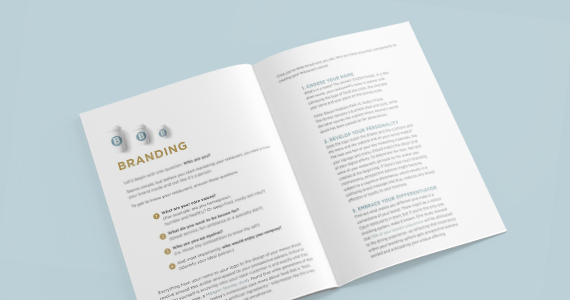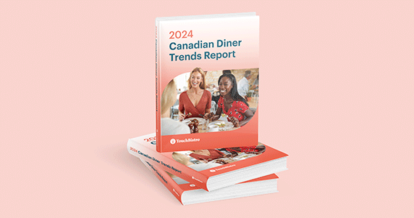Market research for your restaurant doesn’t end after your grand opening.
You should be conducting market research every year to make sure your restaurant is still giving your customers what they want.
In a market that’s home to more than 1 million restaurant locations in the U.S. alone, you need to really know your customers. You need to know their hopes, dreams, and … what they want to eat.
So that you really do know, you’ll need to conduct some market research. “Market research” is a broad term that covers many areas of analysis, and some involve more investment of time and resources than others. Here we’ll cover how to use market research to strengthen your restaurant, examples of qualitative and quantitative research, and a couple of ways to perform market analysis that won’t break the bank.

Everything you need to know about social media, digital marketing, SEO, and more!
How to Use Market Research for Restaurants
Before we tell you how to conduct market research, you’ll want to know how you can use it to improve your business. Here are three goals to keep in mind when you’re conducting market research for your restaurant.
1. Improve Your Customers’ Experience
Market research will give you the framework to tackle any “blind spots” in your customer experience. You can assume there will always room for improvement in this area: but do you know exactly how you can make your customers’ experience better? If you’re not confident you do, it’s time to gather some information from your customers.
How to gather information:
- Send a survey to your customers
- Include comment cards on tables
- Ask for feedback after their meal
- Read reviews on review sites
2. Remain on Trend
As a business owner, you need a complete understanding of how consumer preferences are changing. So whether your customers’ penchant for delivery is waning or they’re craving all things turmeric, you need to be aware early and take the necessary steps to get on trend before you’re left behind.
How to gather information:
- Read consumer survey results, such as TouchBistro’s Diner Trends Report.
- Read the Restaurants Canada Restaurant Outlook Survey
3. Gain a Competitive Advantage
Is that trendy bar down the road stealing your midweek clientele with their half-priced wing Wednesdays? When you know what your competitors are doing, you can supersede their strategy by adding a better promotion to attract customers back to your venue.
How to gather information:
- Subscribe to your competitors’ e-newsletters
- Follow your competitors’ social media feeds
- Bookmark and check your competitors’ websites
- Bookmark and check your competitors’ reviews on popular review site

Everything you need to know about social media, digital marketing, SEO, and more!
How to Conduct Market Research for Restaurants
There are two types of market research: qualitative and quantitative research.
Qualitative research isn’t about numbers – it’s about thoughts and opinions. If you want to know more about your customers’ experiences and preferences, qualitative research is the way to go.
Methodologies for qualitative research:
- Interviews
- Focus groups
- Archival research
Let’s focus on … focus groups. Focus groups enable you to conduct an intimate Q&A session to determine the appetite for your concept and learn more about your target market. Here’s how to host a focus group for your restaurant in eight steps.
1. Set Your Goals.
What specific information are you looking to gather? In this case, your goal is likely to learn more about your target market’s dining behaviors and values.
2. Select a Location for the Focus Group.
It should be comfortable and relaxed. Keep in mind that you’ll have to record the conversation for your reference later. The space should be quiet enough for recording.
3. Prepare Your Questions.
Use ‘yes’ and ‘no’ questions sparingly. Use open-ended questions that will require a thoughtful response from participants. Use a funnel approach. Start with general, broad sweeping questions, then narrow your questions to get more specific answers. Limit yourself to 10-12 questions.
4. Recruit Participants.
Participants should be as objective as possible. To find objective participants, place an ad on social media or in publications like a local newspaper. If that’s not in the budget, you can also get friends to ask their network. That way you get an unbiased third parties to take part. Focus groups are usually made up of five to ten participants. Feel free to offer incentives like gift cards or loot bags.
5. Collect Demographic Information.
During your focus group, ask participants to fill out a confidential demographic form in advance of the focus group. Include fields for:
- Age
- Gender
- City
- Neighborhood of residence
- Marital status
- Children
- Profession
- Income bracket
6. Hand Out a Release Form.
Outline the purpose of the study. Confirm that the participant understands they will be recorded. Describe how the research will be used.
7. Ask Your Questions.
As you go through your questions, your job is also to keep participants on track. Reroute them if they get off course and prompt them for further details if their answers are short-winded. Be curious, wear a smile and make eye contact.
8. Analyze Your Recording and Findings.
Using your questions as a guideline, record your participants answers, preferences and behaviors. Identify trends in their responses.
Quantitative research is all about the numbers. It involves larger sample sizes (more people) and statistical and numerical data. If you want data from a lot of people, you’ll need to use a quantitative research method to gather what you need.
Methodologies for quantitative research:
- Experiments
- Polls
- Surveys
Executing a Successful Survey
Let’s focus on surveys. Surveys allow you to gather anonymous feedback from more people with less time and commitment than a focus group. Here’s how to conduct a survey in seven steps.
1. Set Your Goals.
What specific information are you looking to gather? In this case, your goal is likely to learn more about your target market’s dining behaviors and values.
2. Collect Demographic Information.
Begin your survey by collecting demographic information. When you’re conducting your analysis, this will help you sort your target market’s answers from general survey responses.
3. Use Close-Ended Questions.
On a survey, open-ended questions can exhaust respondents. Respondents can answer close-ended questions faster and from their gut. When it comes time to analyze your survey results, close-ended questions are quantitative. Quantitative responses will lead you to general conclusions, faster. Close-ended questions are framed using the following scales:
Likert Scale
Best used for: Measuring behavior and feelings
Strongly Agree – Agree – Undecided / Neutral – Disagree – Strongly Disagree
Always – Often – Sometimes – Seldom – Never
Extremely – Very – Moderately – Slightly – Not at all
Excellent – Above Average – Average – Below Average – Very Poor
Example:
Question: Before visiting a restaurant, I look at their website online.
Answer: Always – Often – Sometimes – Seldom – Never
Nominal Scale
Best used for: demographic information, like age and income
1-9, 10-19, 20-29
Example:
Question: What is your age?
Answer: Under 21 – 22 to 35 – 36 to 49 – 50+
Dichotomous Scales
Best used for: Precise answers and data measuring
Yes or No
True or False
Fair or Unfair
Agree or Disagree
Example:
Question: I am interested in trying a new cuisine.
Answer: True or False
Multiple Choice
Best used for: Questions that could have more than one answer
Example:
Question: Which of the following proteins do you like?
Answer: Beef – Chicken – Fish – Tofu – Other (Please specify)
Single Choice Questions
Best used for: Questions that ask respondents to determine their favorite choice
Example:
Question: What protein do you select most often?
Answer: Beef – Chicken – Fish – Tofu – Other (Please specify)
When creating survey questions, avoid the following errors:
Leading questions: Do your best to create objective questions. Don’t ask, “Would you dine at an amazing restaurant if they played terrible country music?” Instead ask, “What music would deter you from dining at a restaurant? Choose the answer that most applies. Rock – Country – Indie – Classical – Top 40 – Oldies – Reggae – Rap – Other (please specify)”
Double-barrelled questions: Double-barrelled questions force respondents to answer two questions at once. For example: “Would you order takeout from a restaurant that offered Indian cuisine and was only open until 9:00pm?”
4. Create the Survey.
Create digital surveys using one of the following tools:
5. Test Your Survey.
Always test your survey before you distribute it to your target market. Your survey should take no longer than seven to eight minutes to complete. To test your survey, send it out to five members of your personal network. Ask them to review the survey questions for clarity, spelling, and general flow. Once they’ve completed the survey, download their responses so you can see how the survey tool organizes and presents the results. You might find you need to adjust formatting or response types if the information isn’t organized in a logical way.
6. Distribute Your Survey.
You can buy targeted respondents from any one of the survey tools listed above. If you’re on a budget, distribute the survey to your network. Then ask that network to distribute the survey to their network, and so on.
7. Analyze Responses and Apply Them to Profiles.
While the general population’s information is still valuable, pay close attention to your target market’s answers. As you identify psychographic and behavioral information trending within your target market, you can add these insights into your target market profiles.

Everything you need to know about social media, digital marketing, SEO, and more!
Tools for Conducting Market Research for Restaurants
MyBestSegments
A tool that provides researchers with lifestyle and demographic behavior of a specific area, MyBestSegments shows competitor and consumer trends as they shift.
Hootsuite
Hootsuite’s dashboard allows you to monitor social media hashtags so you can see people are saying about the restaurant industry.
Social Mention
Similarly to Hootsuite, Social Mention shows you recent posts that contain keywords of your choice.
SurveyMonkey
A platform that allows you to easily create and distribute surveys to your audience for polling purposes. SurveyMonkey’s survey tool is great for gathering customer feedback in email campaigns and newsletters.
Survey Anyplace
Survey Anyplace lets you customize your own restaurant survey template so you can see what guests think about their experience. From questions on food service to affordability, the survey gives you some great information on your restaurant’s performance.
Feedly
Think of Feedly as your own personal newspaper. With content aggregators like Feedly, you choose the publications and RSS feeds you’d like to follow and they organize them in a lovely, easily digestible daily package.
Market Research Firms
For those who want to make the most of all kinds of market research, market research consultants do it all, from creating and distributing surveys to holding focus groups, concept testing, testing brand image, and brand reception.
New restaurants are emerging every day – so there’s no shortage of competition in the restaurant industry. Leverage market research and its insights to help your restaurant remain competitive and on trend. You’ll find you can offer a better customer experience after you’ve taken the time to dig into their preferences – and then everyone is a winner.
Free social media templates for your restaurant







